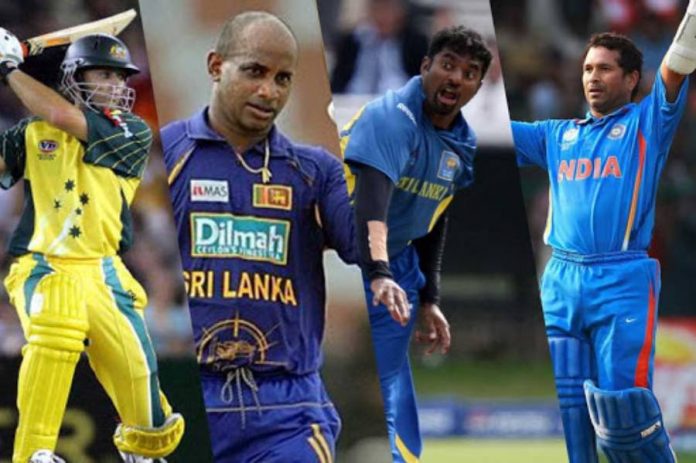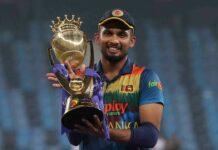Continuing from the previous article, this sequel will feature the star names who mesmerized the game at its foremost stage. This lineup will include outstanding individuals who enthralled at the World Cup between 1992 and 2011.
Sanath Jayasuriya (Sri Lanka)
When the ‘Master Blaster’ came into bat, every target seemed trivial. His aggressive stroke play along with sheer timing was nothing but a nightmare for the bowlers. When he was in the mood, by the time his brief stint ended, it was ‘game over’ for the opponents. Although his career began as a middle order batsman, he was promoted to the top by Ranatunga to exploit the fielding restrictions. It proved to be an instant success as he revolutionized the ‘pinch hitting’ concept that was initiated by Mark Greatbatch in 1992. Jayasuriya’s important role in their World Cup winning campaign in 1996 not only earned him the player of the tournament award but also created a brand for himself.
Along with ‘Little Kalu’, the duo provided the perfect start Sri Lanka needed in 1996. In Delhi, his opening salvo yielded 79 runs, spearheading an impressive run-chase against India. Later in a crucial QF clash against England, Jayasuriya slammed 82 off 44 balls, quite dramatic in context. His nifty spin and athleticism on the field came in handy when he laid the first brick to turn the semi-final against India, causing the stumping of Tendulkar as he ended the match with 3 wickets, two catches and a run-out. Sanath Jayasuriya has scored 1165 runs including 3 centuries. Jayasuriya’s left arm spin, captured 27 wickets while his safe hands claimed 18 catches, only behind Australia’s Ricky Ponting.
Mark Waugh (Australia)
The stalwart from down under was one of the most accomplished batsmen in Cricket. His graceful drives and ability to hoist the ball spoke for itself when he opened with skipper Mark Taylor in 1996. Against Kenya at Visakhapatnam Waugh muscled his way to 130 that included a 207-run stand with his twin Steve, the first 200+ partnership in a World Cup. In the following game, he scored a stylish 126 against India, becoming the first batsman to score consecutive centuries in the World Cup. During the quarter-final against New Zealand, Australia successfully chased down 286 with another refined century by Waugh. His fourth century came in 1999, thus making him the first player to score 4 tons in the World Cup while his composed fielding forced the run-out in the bizarre semi-final tie. Waugh’s heroics has seen him scoring 1004 runs at an average of 52.84.
Sachin Tendulkar (India)
Would an all-star lineup be complete without the ‘Little Master’? With six tournament appearances, 44 innings, 2278 runs (avg. 56.95), 6 centuries and 15 half centuries it is a cakewalk for Tendulkar to seal his name in the list. Making his debut as a 19-year-old in 1992, it was a strenuous journey until he won the ultimate prize in 2011. Among his scintillating knocks were his quick-fire 90, and an elegant 137 against Australia and Sri Lanka in 1996. He returned after his father’s funeral during the 1999 edition to score an unbeaten 140 against Kenya, displaying absolute courage and competence. Tendulkar’s best of 152 came in 2003 against Namibia as he ended the tournament with 673 runs in 11 innings. By the time he ended the 2011 show with 482 runs (avg. 53.5), the prize was already in his hands as his teammates carried the perennial legend on their shoulders. And so was the patent relief of a 19-year burden.
Ricky Ponting (Australia) – Captain
Other than him, maybe it was only Clive Lloyd who led a heartless alliance of ruthless domination in World Cup cricket. As a debutant in 1996, Ponting became the youngest centurion in the World Cup with his 102 against the mighty Windies at Jaipur. After a winning campaign in 1999, he took the baton from Steve Waugh, beginning an era of supreme authority on the big stage. In the 2003 finals, he pummeled 140 in 121 taking the game away from India to secure their title. In 2007 too, he led the star-studded outfit to complete their treble. Ponting claims 3 titles, 2 as a captain. His 29 games as a captain has produced 26 wins while his willow has spoken with 1743 runs (avg. 45.86) that included 5 centuries and 6 half centuries. As an outstanding fielder, Ponting has secured 28 catches, the most by an outfield player, with 11 of them coming in 2003.
Aravinda de Silva (Sri Lanka)
Imagine a 1996 campaign without Aravinda de Silva. Has anyone dominated a World Cup final like Aravinda did in 1996? His 1064 runs (avg. 36.38) came in 32 innings, 448 of which was made in 1996 at a fabulous average of 89.60. His delightful drives and pulls combined with his pressure handling skills were vital in Sri Lanka’s winning chemistry. At Asgiriya against Kenya, Aravinda stormed his way to 145 in 115 balls, the first ODI century by a Sri Lankan in a World Cup. When both openers perished at Eden Gardens in the semi-finals, the ‘Mad Max’ continued to play his own game, forging 66 in 47 balls. Later in an all-important final, Aravinda captured 3 wickets and two catches before mastering an unbeaten century when the chips were down to seal a momentous win for the islanders. Not only was he awarded the Man of the Match in the finals, but he also left an everlasting memory in every Sri Lankan heart.
Adam Gilchrist (Australia) – Wicketkeeper
He is perhaps the finest Wicketkeeper/Batsman ever to play in a World Cup. His vigorous talents as an opener dispensed absolute carnage, notwithstanding his glovemanship that victimized 52 batsmen in the World Cup. In 1999 finals, Gilly opened with Mark Waugh for a rapid 54 in an easy run-chase before teaming up with his longstanding ‘partner in crime’ Matthew Hayden. In 2003, he scored 408 runs (avg 40.8, SR 105) including 57 runs in the final. His most imposing innings came in the 2007 final when he clobbered 149, the highest ever score in a World Cup final. Gilly’s willow has produced 1085 runs while his 52 dismissals in 31 innings (1.677 per game) remains the highest including 21 (10 innings) in 2003. He remains the only cricketer to win all three World Cups he has played in.
Lance Klusener (South Africa)
The ‘Zulu’ was a sensation in the 1999 edition. Although his valiant efforts went in vain in the bizarre semi-final, his explosive middle order cameos earned him 4 Man of the Match awards in 8 games including the Player of the Tournament. His batting average of 124 remains the best in tournament history and so is Klusener’s SR of 121.17. Appearing in just two World Cups, he scored 372 runs in 11 innings. 250 runs came through his assaults in 1999 with 17 wickets from his medium pace. Klusener’s World Cup career was short-lived but his impact on the stage was eternal.
Shane Warne (Australia)
When the greatest leg spinner debuted in 1996, his mastery in leg breaks, flippers and his ability to find turn on almost any track earned him 12 scalps. During the semi-final at Mohali, Warne turned the game with 4 for 36 against the West Indies. In the following campaign, Warne dismissed Gibbs with a peach, a reminiscence of his delivery to Mike Gatting in 1993. He ended the semi-final with 4 for 29 before dismantling the Pakistani line-up in the final with his wizardry, claiming 4 for 33. Playing in a mere two World Cups, Warne has taken 32 wickets in 17 games, including four 4-wicket hauls.
Wasim Akram (Pakistan)
One of the finest left-arm seamers to grace the World Cup, Akram came into the spotlight when his pongo of 33 runs in 19 balls and 3 wickets sealed the fate of the 1992 final. He gobsmacked the 87,000 audience at the MCG when his unplayable deliveries sent back Ian Botham, Allan Lamb and Chris Lewis, turning the game at a crucial juncture. The hero in the ’92 finals has taken 55 wickets in 36 innings (only to be behind Murali and McGrath) and scored 426 runs with 11 sixes. In 1999 he led the Pakistanis to the finals, while he claimed 12 wickets in his farewell in 2003.
Glenn McGrath (Australia)
A list won’t be complete without the all-time great Glenn McGrath in it. With 71 wickets in 39 innings, he dominated the bowlers’ list with his swing and pace. His career involves two 5-wicket hauls and staggering 42 maidens while his best of 7 for 15 came against Namibia at Potchefstrom in 2003. McGrath’s 18.19 average, 3.96 economy and 27.5 strike rate has displayed the tight bowling bestowed upon his opponents. His final appearance in 2007 saw him securing 26 scalps, before leaving the stage as a three-time World Champion.
Muttiah Muralitharan (Sri Lanka)
The best off-spinner ever to feature in the World Cup is only behind McGrath with 68 wickets (avg. 19.63) in 39 innings. His humble smile often deceived the batsmen through his intense eye for prey. As a youngster, Murali’s role with his agile spin came handy in Sri Lanka’s winning campaign in 1996 when he grabbed 7 wickets. His stunning economy rate of 3.88 and strike rate of 30.3 was backed by his four 4-wicket hauls. In 2007, he captured 23 wickets for the tournament while his farewell in 2011 saw him trapping Scott Styris with his last ODI ball on home soil.
Chaminda Vaas (Sri Lanka)
Without a doubt, Vaas was the best left-arm seamer Sri Lanka has ever produced. His opening ammunition always carried the potential to claim that much anticipated early breakthrough. From his debut in 1996, Vaas has taken 49 wickets in 31 innings (avg. 21.22, econ 3.97) with his best of 6 for 25 coming against Bangladesh in 2003. In the same match, he claimed a hat-trick off the first three balls of the game, the only instance of such an occurrence in ODI history before capturing one more, leaving them 5/4 at the end of the opening over. He subsequently ended the 2003 tournament with 23 wickets. Vaas’ sublime World Cup career also carry 39 maiden overs.
Beginning from 1975, the sequel, featured the startling individuals who mesmerized the ultimate showdown in the grandest manner. The World Cup is a different stage, it’s a stage that you have only a few chances to become a hero and these line-ups have resembled the greatest players in the history of the World Cup, because they have taken that chance with open arms and created a legacy in the world’s most watched cricketing extravaganza. Remember, strictly World Cup only.
























